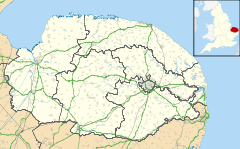- Melton Constable
-
Coordinates: 52°51′26″N 1°01′58″E / 52.85734°N 1.0329°E
Melton Constable
 Melton Constable shown within Norfolk
Melton Constable shown within NorfolkArea 6.96 km2 (2.69 sq mi) Population 518 - Density 74 /km2 (190 /sq mi) OS grid reference TG042331 Parish Melton Constable District North Norfolk Shire county Norfolk Region East Country England Sovereign state United Kingdom Post town MELTON CONSTABLE Postcode district NR24 Police Norfolk Fire Norfolk Ambulance East of England EU Parliament East of England List of places: UK • England • Norfolk Melton Constable is a village and civil parish in the English county of Norfolk. It covers an area of 6.96 km2 (2.69 sq mi) and had a population of 518 in 225 households as of the 2001 census.[1] For the purposes of local government, it falls within the district of North Norfolk. The village sits on fairly high ground south-west of Holt.
The place-name 'Melton Constable' is first attested in the Domesday Book of 1086, where it appears as 'Maeltuna'. This may mean either 'middle town' or 'mill town'. There is a reference to 'Constabularius de Melton' in 1197, as the land was held by the constable of the bishop of Norwich.[2]
Contents
Railway
Melton Constable reached its heyday about 1911; in the census of that year[3] it had a population of 1,157. It was a new town built in 1880s at the junction of four railway lines, which came from Cromer, North Walsham, King's Lynn and Norwich and linked Norfolk to the Midlands. A station with a platform 800 feet (240 m) long was constructed with a specially-appointed waiting room for Lord Hastings, the local squire. The Midland and Great Northern Joint Railway's main workshops and factory were also situated in the village, helping to give it the character of a rural industrialised village (rather similar to Woodford Halse in Northamptonshire). The workshops were often called the Crewe Works of North Norfolk. When in M&GNJR hands the works built 19 steam locomotives. Under LNER ownership the works was gradually degraded until 1934 when they closed completely. Between 1959 and 1964 British Railways closed the lines and withdrew both passenger and goods services from Melton Constable, which resulted in the slow decline of the village; it now lies stranded in the middle of a vast agricultural area which uses other forms of transport. In 1971 the station was demolished and the works were converted into an industrial estate.
The railways may eventually return to Melton Constable as part of the Norfolk Orbital Railway which would have a station there.
Hall
Melton Constable Hall is regarded as the finest specimen of the Christopher Wren style of house. The house was re-modelled and extended by Sir Jacob Astley between 1664 and 1670. It has some fine plaster ceilings dated 1687, probably fashioned by Edward Goudge. The core of the house is Elizabethan.
Between the church and the hall there stands a tower known as Belle Vue, which has a view of Norwich and the sea.
Belle Vue is in fact in Briningham, some 2 miles (3.2 km) from the Hall and not between the Hall and the church in Melton Park, although it could just be described as between the Hall and St. Peter's Church in Swanton Novers. It was a smock-mill that was built by Sir Jacob Astley, 1st Baronet, of Melton Constable Hall in 1721. The mill was not much used. Sir Edward Astley, the 4th Baronet, replaced the wooden tower with a brick one c. 1775. The new tower was built over the existing three-storey brick, octagonal base, is the only one of its type in the county and is the oldest base in the county. It fell into dereliction and remains on the English Heritage at Risk register, as do a number of outbuildings on the estate. The following are listed as at Risk as of April 2010 - Melton Constable Hall, Melton Constable Hall stable court west and north wings, Melton Constable Hall Terraces, The Bath House Melton Constable Park, and The Teahouse Melton Constable Park. This data can be readily accessed on line at the Norfolk County Council web site, Buildings at Risk Register.
Park
Melton Constable Park was designed by Capability Brown in 1764–69; it has a church, a temple and various artistic follies. The church, which is small and unusual, nestles under trees (yews, firs and oaks) and can be reached by a drive lined with rhododendrons. It contains Norman work and many memorials to the Astley family who bear the title Lord Hastings. Sir Jacob Astley fought in the English Civil War and his prayer is still quoted by many: "Lord, I shall be very busy this day. I may forget Thee but do Thou not forget me".
The film The Go Between was filmed here.
Over the years some local people have been concerned about the state of the hall and its surrounding buildings. Parts of it are now very run-down. A recent article in the local newspaper, the Eastern Daily Press, had some details of the condition it is in and gave information about the business dealings of the owner.
References
- ^ Census population and household counts for unparished urban areas and all parishes. Office for National Statistics & Norfolk County Council (2001). Retrieved 20 June 2009.
- ^ Eilert Ekwall, Concise Oxford Dictionary of English Place-names, p.321.
- ^ Bartholomew's Gazetteer of the British Isles, 1914 edition
External links
 Media related to Melton Constable at Wikimedia CommonsCategories:
Media related to Melton Constable at Wikimedia CommonsCategories:- Villages in Norfolk
- Villages in Norfolk connected with houses of historical interest
- Railway towns in England
- Civil parishes in Norfolk
- Country houses in Norfolk
Wikimedia Foundation. 2010.


